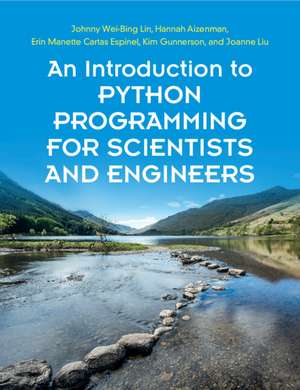An Introduction to Python Programming for Scientists and Engineers
Autor Johnny Wei-Bing Lin, Hannah Aizenman, Erin Manette Cartas Espinel, Kim Gunnerson, Joanne Liuen Limba Engleză Paperback – 6 iul 2022
Preț: 401.66 lei
Preț vechi: 436.58 lei
-8% Nou
Puncte Express: 602
Preț estimativ în valută:
76.87€ • 78.72$ • 63.94£
76.87€ • 78.72$ • 63.94£
Carte disponibilă
Livrare economică 26 februarie-12 martie
Livrare express 11-15 februarie pentru 71.45 lei
Preluare comenzi: 021 569.72.76
Specificații
ISBN-13: 9781108701129
ISBN-10: 1108701124
Pagini: 766
Dimensiuni: 189 x 245 x 31 mm
Greutate: 1.6 kg
Ediția:Nouă
Editura: Cambridge University Press
Colecția Cambridge University Press
Locul publicării:New York, United States
ISBN-10: 1108701124
Pagini: 766
Dimensiuni: 189 x 245 x 31 mm
Greutate: 1.6 kg
Ediția:Nouă
Editura: Cambridge University Press
Colecția Cambridge University Press
Locul publicării:New York, United States
Cuprins
Part I. Getting Basic Tasks Done: 1. Prologue: Preparing to Program; 2. Python as a Basic Calculator; 3. Python as a Scientific Calculator; 4. Basic Line and Scatter Plots; 5. Customized Line and Scatter Plots; 6. Basic Diagnostic Data Analysis; 7. Two-Dimensional Diagnostic Data Analysis; 8. Basic Prognostic Modeling; 9. Reading In and Writing Out Text Data; 10. Managing Files, Directories, and Programs; Part II. Doing More Complex Tasks: 11. Segue: How to Write Programs; 12. n-Dimensional Diagnostic Data Analysis; 13. Basic Image Processing; 14. Contour Plots and Animation; 15. Handling Missing Data; Part III. Advanced Programming Concepts: 16. More Data and Execution Structures; 17. Classes and Inheritance; 18. More Ways of Storing Information in Files; 19. Basic Searching and Sorting; 20. Recursion; Part IV. Going From a Program Working to Working Well; 21. Make it Usable to Others: Documentation and Sphinx; 22. Make it Fast: Performance; 23. Make it Correct: Linting and Unit Testing; 24. Make it Manageable: Version Control and Build Management; 25. Make it Talk to Other Languages.
Recenzii
'This book provides an excellent introduction to the Python language especially targeted at those interested in carrying out calculations in the physical sciences. I especially like the strong coverage of graphics and of good coding practice.' Raymond Pierrehumbert, University of Oxford
'An excellent introduction to Python for scientists and engineers. Much more than teaching you how to program with Python, it teaches you how to do science with Python.' Eric Shaffer, University of Illinois at Urbana-Champaign
'Python has achieved an essential role in many disciplines within science, engineering, and beyond. Students and professionals are expected to be fluent in it, and (as I see in my daily job of helping users of a high-performance computing facility) they often struggle to reach that fluency. The authors have succeeded in the daunting task of writing a single book to help people reach a very advanced level of fluency, starting very gently and assuming no background. Unlike other books on the subject, An Introduction to Python Programming for Scientists and Engineers focuses on teaching for the intended end goal of scientists and engineers - investigating their scientific problems - not writing software for its own sake. I am looking forward to working with the generation who will learn how to program in Python using this book!' Davide Del Vento, NCAR Computational & Information Services Laboratory
'An Introduction to Python Programming for Scientists and Engineers introduces programming in Python using evidence-based approaches to active learning. The exercises help both students and instructors identify misconceptions in programming, allowing students to build a strong foundation in Python programming. The book streamlines content such that there is a focus on mastering immediately useful concepts, normalizing errors, and demonstrating recovery.' Kari L. Jordan, Executive Director, The Carpentries
'An excellent introduction to Python for scientists and engineers. Much more than teaching you how to program with Python, it teaches you how to do science with Python.' Eric Shaffer, University of Illinois at Urbana-Champaign
'Python has achieved an essential role in many disciplines within science, engineering, and beyond. Students and professionals are expected to be fluent in it, and (as I see in my daily job of helping users of a high-performance computing facility) they often struggle to reach that fluency. The authors have succeeded in the daunting task of writing a single book to help people reach a very advanced level of fluency, starting very gently and assuming no background. Unlike other books on the subject, An Introduction to Python Programming for Scientists and Engineers focuses on teaching for the intended end goal of scientists and engineers - investigating their scientific problems - not writing software for its own sake. I am looking forward to working with the generation who will learn how to program in Python using this book!' Davide Del Vento, NCAR Computational & Information Services Laboratory
'An Introduction to Python Programming for Scientists and Engineers introduces programming in Python using evidence-based approaches to active learning. The exercises help both students and instructors identify misconceptions in programming, allowing students to build a strong foundation in Python programming. The book streamlines content such that there is a focus on mastering immediately useful concepts, normalizing errors, and demonstrating recovery.' Kari L. Jordan, Executive Director, The Carpentries
Notă biografică
Descriere
Textbook that uses examples and Jupyter notebooks from across the sciences and engineering to teach Python programming.
